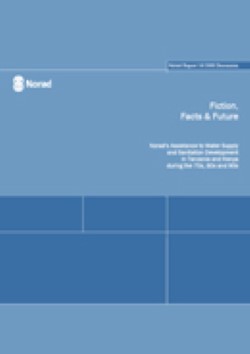Fiction, Facts & Future : Norad’s Assistance to Water Supply and Sanitation Development in Tanzania and Kenya during the 70s, 80s and 90s
Om publikasjonen
- Utgitt: mai 2008
- Serie: Norads rapportserie
- Type: Norad-rapport
- Utført av: Oddwin Skaiaa, Tranor International
- Bestilt av: Norad
- Land: Kenya, Tanzania
- Tema: Vann og sanitær
- Antall sider: 20
- Serienummer: 16/2008
- ISBN: 978-82-7548-300-1
- ISSN: --

The International Drinking Water Supply and Sanitation Decade (1981-90) ended without reaching its declared goal of providing all people with safe drinking water and proper sanitation. High population growth rates in the developing countries hampered and reduced the coverage. Other hindering factors included the lack of appropriate technology, the preference of the small privileged urban areas over the vast rural areas, the lack of the simultaneous approach in the development of water and sanitation and
poor involvement of health education in the activities of the Water Decade. The water and sanitation development activities of the last decade have to be carried forward and continued during the present decade, in a different approach and alternative methods.
In the Millennium Development Goals (MDGs) new targets were agreed upon and the world committed itself to halving by 2015 the number of people without access to water and sanitation. In translating the MDGs into quantitative targets at country level we need to take the key lessons from the "Decade" into account. In the Norwegian government's Action Plan for Environment in Development Cooperation water is a priority area.
Norway intends to assist priority countries in achieving water and sanitation targets, focusing particularly on sanitation.
During the Decade Norway was a major donor to water supply and sanitation. In several African countries Norway supported extensive programs, most of which were closed in the early 90s. Many people have claimed that since the Decade did not achieve its intended goal it was a failure and claims have been made that the Norwegian support was not sustainable. Is this a reality or a myth? As an answer to this question this consultancy was undertaken. The results documented in this report and verified by the receiving governments are quite striking.
The main purpose of this report is to answer the question - fiction of fact? - and to provide an update on the status of the Norwegian investments made on the water supply and sanitation sector in Tanzania and Kenya during the 1970s, 80s and 90s. Can lessons be drawn from these programmes for the benefit of future programmes?
The adopted review methodology is a blend of archive search and literature studies, interviews and field work. This Executive Summary is intended to provide a brief description of the most important features of the review and to present the main conclusions. Chapter 1 provides an introduction to the review's background, approach and methodology, and a reference to the history behind the programmes. Chapter 2 provides a reference to the Sub-Reports, including an introduction to the "North" and "South" perspectives and the correlation between the two. Chapter 3 presents a summary of the conclusions of the review. Separate Sub-Reports have been prepared for Tanzania and Kenya. They are not enclosed this Executive Summary, but can be found in the Main Report as Annex 2 and 3 respectively, or viewed as separate Sub-Reports.
